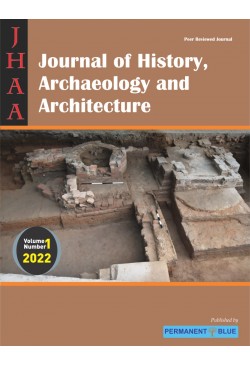
Journal of History, Archaeology and Architecture
Frequency :Bi-Annual
ISSN :2583-5106
Peer Reviewed Journal
Bifaces and Cleavers on Flakes and Core at Ramba, a well-developed Lower Palaeolithic site in the Suvarnarekha- Burahabanga Complex
Arabinda Singha Roy 2022. Bifaces and Cleavers on Flakes and Core at Ramba, a well-developed Lower Palaeolithic site in the Suvarnarekha-Burahabanga Complex. Journal of History, Archaeology and Architecture, 1: 1, pp. 1-15.
Salvaging the Bead Manufacturing Area at Mahurjhari, Nagpur
Manoj Kumar Kumri 2022. Salvaging the Bead Manufacturing Area at Mahurjhari, Nagpur. Journal of History, Archaeology and Architecture, 1: 1, pp. 17-23.
The Archaeological Findings Around Ruins Temple’s of Kalachuri Period of Rewa District of Madhya Pradesh, India
Aniruddh Bahuguna, C.D. Singh & Asif Rashid Raina 2022. The Archaeological Findings around Ruins Temple’s Kalachuri Period of Rewa District of Madhya Pradesh, India. Journal of History, Archaeology and Architecture, 1: 1, pp. 25-34.
Study of Vanishing Remains of the Kashmir Neolithic Culture: An Overview
Naheed Ahmed & Yogambar Singh Farswan 2022. Study of Vanishing Remains of the Kashmir Neolithic Culture: An Overview. Journal of History, Archaeology and Architecture, 1: 1, pp. 35-46.
Archaeological Findings within Last Two Decades in Dist. Nalanda, Bihar
G.K. Lama 2022. Archaeological Findings within last two Decades in Dist. Nalanda, Bihar. Journal of History, Archaeology and Architecture, 1: 1, pp. 47-63.
Domestic Architecture of the Nagas : A Case Study on Traditional Architecture of Mesulumi Village
Dingupe Lasuh 2022. Domestic Architecture of the Naga: A Case Study on Traditional Architecture of Mesulumi Village. Journal of History, Archaeology and Architecture, 1: 1, pp. 65-72.
Economic Development in the Rural Areas of Nagaland under the Initiative of Village Development Boards (VDBs)
Gideon Phesao 2022. Economic Development in the Rural Areas of Nagaland under the Initiative of Village Development Boards (VDBs). Journal of History, Archaeology and Architecture, 1: 1, pp. 73-79.
Lower Palaeolithic in Rajasthan: A Preliminary Study
Vineet Godhal 2022. Lower Palaeolithic in Rajasthan: A Preliminary Study. Journal of History, Archaeology and Architecture, 1: 1, pp. 81-91.
Important Heritage of Pataliputra
Dilip Kumar 2022. Important Heritage of Pataliputra. Journal of History, Archaeology and Architecture, 1: 1, pp. 93-99.